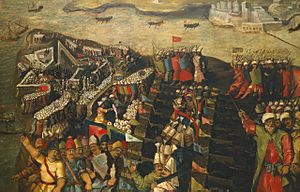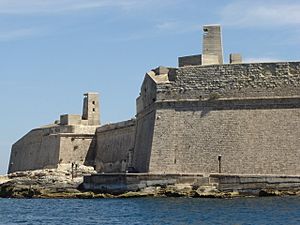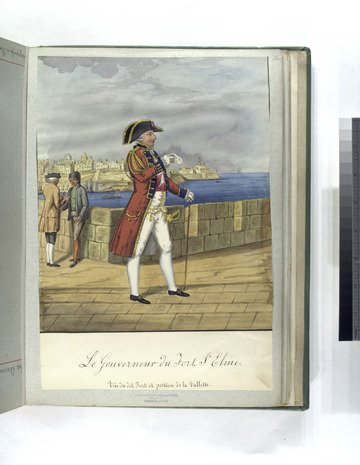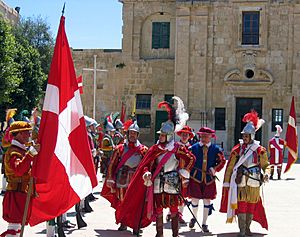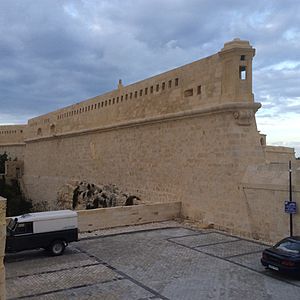Fort Saint Elmo facts for kids
Quick facts for kids Fort Saint Elmo |
|
|---|---|
| Forti Sant'Iermu | |
| Part of the fortifications of Valletta | |
| Valletta, Malta | |
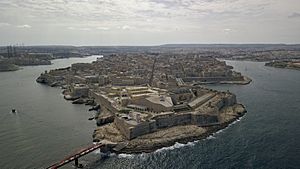
An aerial view of Valletta, showing Fort St. Elmo
|
|
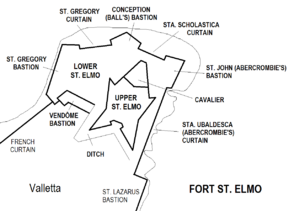
Map of Fort St. Elmo
|
|
| Coordinates | 35°54′07″N 14°31′08″E / 35.9020°N 14.5188°E |
| Type | Star fort integrated into a city wall |
| Area | 50,400 m2 (543,000 sq ft) |
| Site information | |
| Owner | Government of Malta |
| Controlled by | Heritage Malta Police Academy |
| Open to the public |
Yes |
| Condition | Intact |
| Site history | |
| Built | 1552–1570s |
| Built by | Order of Saint John |
| In use | 1552–1972 |
| Materials | Limestone |
| Battles/wars | Great Siege of Malta World War II |
| Events | Rising of the Priests |
| Type | Cultural |
| Criteria | i, vi |
| Designated | 1980 (4th session) |
| Part of | City of Valletta |
| Reference no. | 131 |
| Region | Europe and North America |
Fort Saint Elmo (called Forti Sant'Iermu in Maltese) is a special kind of fort in Valletta, Malta. It's known as a star fort because of its shape. This fort sits right at the end of the Sciberras Peninsula. This peninsula divides two big harbours: Marsamxett Harbour and Grand Harbour.
Fort Saint Elmo guards the entrances to both harbours. It works with other forts like Fort Tigné and Fort Ricasoli to protect the area. The fort is most famous for its important role in the Great Siege of Malta in 1565.
Contents
History of Fort Saint Elmo
Building the Fort
For a long time, people watched the coast from the tip of the Sciberras Peninsula. By 1417, local soldiers had a permanent lookout spot there. In 1488, the Aragonese built a watchtower on Saint Elmo Point. They named it after Saint Elmo, a patron saint.
In 1533, the Order of Saint John made the tower stronger. Its location was very important for defence. In 1551, the Ottoman fleet attacked and sailed into Marsamxett Harbour easily. This showed that the tower was not strong enough.
So, in 1552, the old tower was pulled down. A new star fort began to be built in its place. A Spanish engineer named Pietro Pardo designed it. The fort had special parts like a cavalier and a covertway. Just months before the big siege in 1565, a ravelin was quickly added.
The Great Siege of 1565
In 1565, the Ottomans attacked Malta again. This time, they came with a much larger army. This event is known as the Great Siege of Malta. Fort Saint Elmo became the site of the fiercest fighting.
The fort faced heavy attacks from Turkish cannon. These cannons were placed on Mount Sciberras, which overlooked the fort. Other cannons fired from the north side of Marsamxett Harbour. Today, Fort Tigné stands on that spot.
The fort's first group of defenders included about 150 knights and 600 soldiers. Most of these soldiers were from Spain. There were also 60 armed galley slaves. More defenders could be sent to the fort by boat. They came from forts like Birgu and Senglea across the Grand Harbour.
During the battle, a Turkish cannon misfired. It hit the top of the fort's wall, sending pieces flying. This accident killed the gunner and badly hurt Dragut, an Ottoman admiral. Dragut was one of the Ottomans' best commanders.
Fort Saint Elmo held out for 28 days. It finally fell to the Turks on June 23, 1565. None of the defending knights survived the battle. Only nine Maltese defenders escaped. They swam across the Grand Harbour to Fort St. Angelo. The long fight at Fort St. Elmo was very important. It gave the other two fortresses time to get ready. It also allowed reinforcements from Spain to arrive.
After the Siege: Rebuilding and Changes
After the siege, Grandmaster Jean Parisot de Valette decided to build a new city. This city would be on the peninsula. Construction started in 1566. Francesco Laparelli was sent by the Pope to design the new city's walls. The damaged Fort Saint Elmo was rebuilt. It became part of the new city's defences.
The fort was changed many times in the 1600s. The Vendôme Bastion was built in 1614. In 1687, the Carafa Enceinte was added. This new wall surrounded the entire fort along the shore. Later in the 1600s, the fort was directly connected to the cavalier. Part of the ditch was filled in, covering some of the old walls.
In the 1700s, a new gunpowder storage area (polverista) was built. It was in the Vendome Bastion. Also, storage buildings were added between the main fort and the Carafa Enceinte. These are called Pinto Stores. This area, along with the stores, is known as Lower Saint Elmo.
On September 8, 1775, Fort Saint Elmo was taken over by 13 rebel priests. They also captured Saint James Cavalier. This event is known as the Revolt of the Priests. The Order's flag was replaced with a banner of Saint Paul. The Order quickly took back Fort St. Elmo. The rebels at St. James then surrendered. The rebels were put on trial. Three were executed, and others were sent away or jailed. The heads of the executed men were displayed on St. James Cavalier. But they were removed soon after Emmanuel de Rohan-Polduc became Grandmaster.
British Rule and World War II
The British made more changes to the fort in the early 1800s. They built a new wall for soldiers to fire from. In 1855, the gunpowder storage at Vendome Bastion became an armoury. Some small weapons from the Palace Armoury were moved there. In the 1870s, more work was done on Abercrombie's Bastion. In 1917, the first heart operation on a soldier happened at St. Elmo. Before World War II, gun positions were built for new cannons.
Fort Saint Elmo was the first place in Malta to be bombed from the air. This happened on June 11, 1940. Among those in the fort during the attack was a military doctor, Ċensu Tabone. He later became the President of Malta. He survived, but six other people died in that air raid.
On July 26, 1941, the Italians attacked the Grand Harbour by sea. They used special boats and torpedoes. British radar detected them early. The coastal cannons at Saint Elmo fired as the Italians got close. Fifteen attackers were killed and 18 were captured. All the special torpedo boats were lost, along with two other boats. One of the Italian boats hit St. Elmo Bridge. This bridge connected the breakwater to the peninsula near the fort. The bridge collapsed and was never rebuilt. A new bridge with a similar design was built in 2012.
Parts of the fort were badly damaged during the war. You can still see some of the bombing scars today. The Royal Malta Artillery left the fort on March 26, 1972. This ended its long military history. Some parts of the fort were then not used for a while.
Fort Saint Elmo Today
In 2008, the World Monuments Fund put Fort Saint Elmo on its list of the 100 Most Endangered Sites. This was because the fort was falling apart. It needed maintenance and security. It was also getting old and exposed to the weather.
Major restoration work began in 2009. By 2014, the upper part of Saint Elmo and the Carafa enceinte were almost fully restored. The restoration was finished in 2015. Lower Saint Elmo was also cleaned up. Plans are being made to restore that area too.
Since 1975, part of the fort has been home to the National War Museum. This museum shows military equipment and items from World War I and II. A copy of the George Cross was also on display. This medal was given to Malta by King George VI in April 1942. The museum closed in September 2014. It reopened in May 2015 with a bigger collection.
Fort Saint Elmo also houses Malta's police academy. Other parts of the fort are used for historical military shows. These shows are called In Guardia and Alarme.
During the restoration, archaeologists dug up parts of the fort. They found pieces of the original fort from before 1565. This was an important discovery. Not much of the original fort remained. This is because Laparelli rebuilt it in 1566. It was also changed a lot between the 1600s and 1800s.
In November 2015, the fort was used as a media center. This was for the Valletta Summit on Migration. Foreign journalists said it was "the most stunning venue which ever hosted an EU summit."
Fort Layout and Design
The original star fort is sometimes called Upper St. Elmo. It has two demi-bastions, two flanks, and two faces. It also has a parade ground, barracks, and a large cavalier. In 1565, the fort included a ravelin. But this was removed when the fort was rebuilt after the siege.
A gate called the Porta del Soccorso is the main entrance to Upper St. Elmo. The 15th-century Chapel of St Anne is inside the fort's walls, near this gate. The 18th-century Church of St Anne is in the parade ground.
After the fortifications of Valletta were built, Vendôme Bastion was added in 1614. It connected the French Curtain to Fort St. Elmo. This bastion has a small lookout tower. It was later used to store gunpowder and then weapons. Now, it is part of the National War Museum.
The Carafa Enceinte was built starting in 1687. It surrounds the original fort and Vendôme Bastion. It includes several bastions and walls:
- St. Gregory Bastion – This bastion has an uneven shape. The British changed it to hold cannons.
- St. Gregory Curtain – This wall connects St. Gregory and Conception Bastions. It has many British gun positions.
- Conception Bastion, also called Ball's Bastion – A small, five-sided bastion. It has gun positions, storage rooms, and places for gun crews. Sir Alexander Ball was buried here.
- Sta. Scholastica Curtain – This wall connects Conception and St. John Bastions. It has a gun position for a very large cannon. It also has other British changes.
- St. John Bastion, also called Abercrombie's Bastion – A large, uneven bastion at St. Elmo Point. This is the very tip of the Sciberras Peninsula. It has several British gun positions and storage rooms. Sir Ralph Abercromby was buried on this bastion.
- St. Ubaldesca Curtain, also called Abercrombie's Curtain – A long wall connecting St. John and St. Lazarus Bastions. It has many British gun positions.
Some barracks (buildings for soldiers) are located between Upper St. Elmo and the Carafa Enceinte.
See also
 In Spanish: Fuerte de San Telmo para niños
In Spanish: Fuerte de San Telmo para niños


